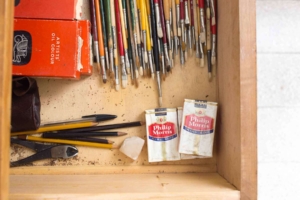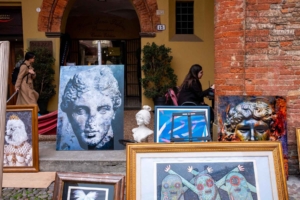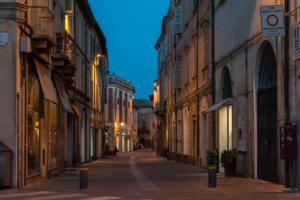See Michelangelo for free? 11 Unmissable Churches in Bologna
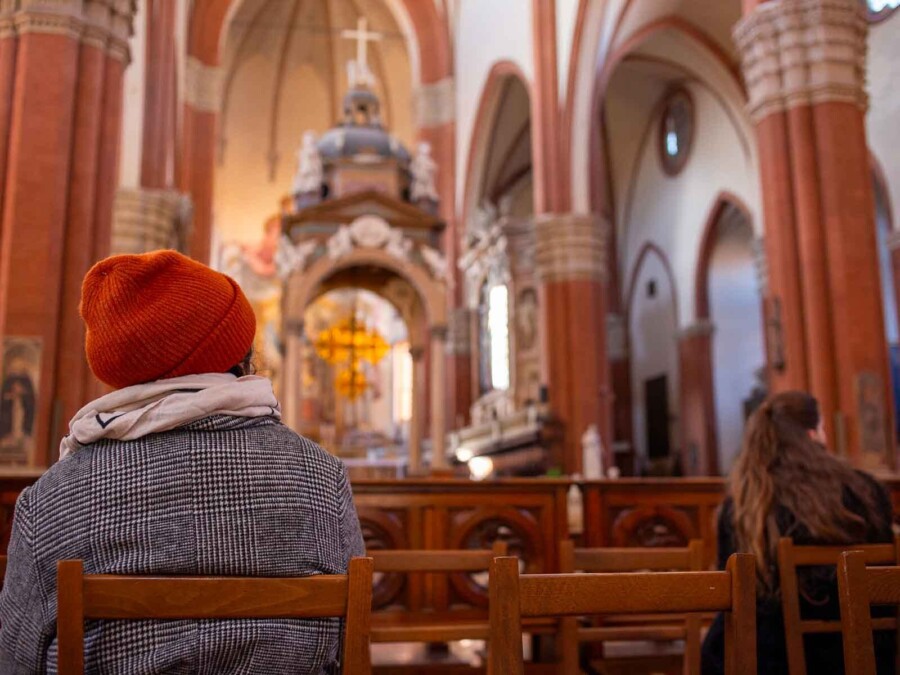
Think churches are boring?
Think again. In Bologna, they hide unfinished dreams, secret staircases, sculptures that scream, and even a walk with 666 arches.
Forget dusty guidebooks — if you want to truly understand this city, follow its domes and bell towers. Behind every altar, there’s a story. Behind every façade, a mystery.
From underground crypts to hilltop sanctuaries, Bologna churches are anything but ordinary.
Here are the 10 must-visit churches in Bologna, complete with tips, legends, and some unexpected surprises.
1. San Petronio
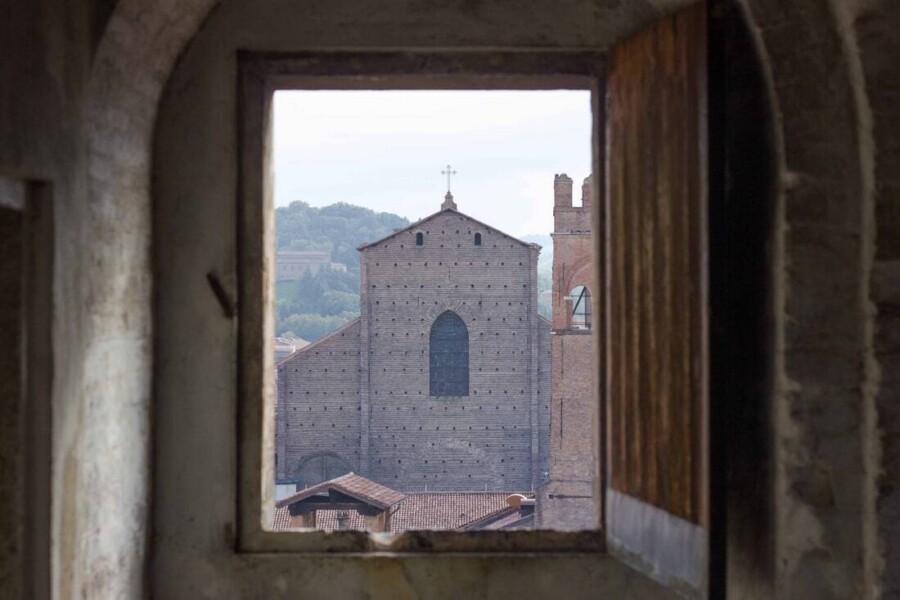
Let’s start with the iconic San Petronio, Bologna’s most famous church.
It looms over Piazza Maggiore and is one of the largest churches in the world. But… have you ever noticed something odd about it?
Its façade is unfinished.
And here’s the mystery: no one knows exactly why.
Some say it was a papal order, fearing the basilica would outshine St. Peter’s in Rome. Others believe it was simply too expensive to cover the massive structure entirely in marble. The truth? Still unknown.
Over the centuries, many famous architects submitted plans to complete it — even recently — but none came to life. And maybe that’s what makes it so unique.
Step inside and you’ll find a long meridian line drawn across the floor, a spectacular organ, and beautifully decorated chapels.
2. Santo Stefano
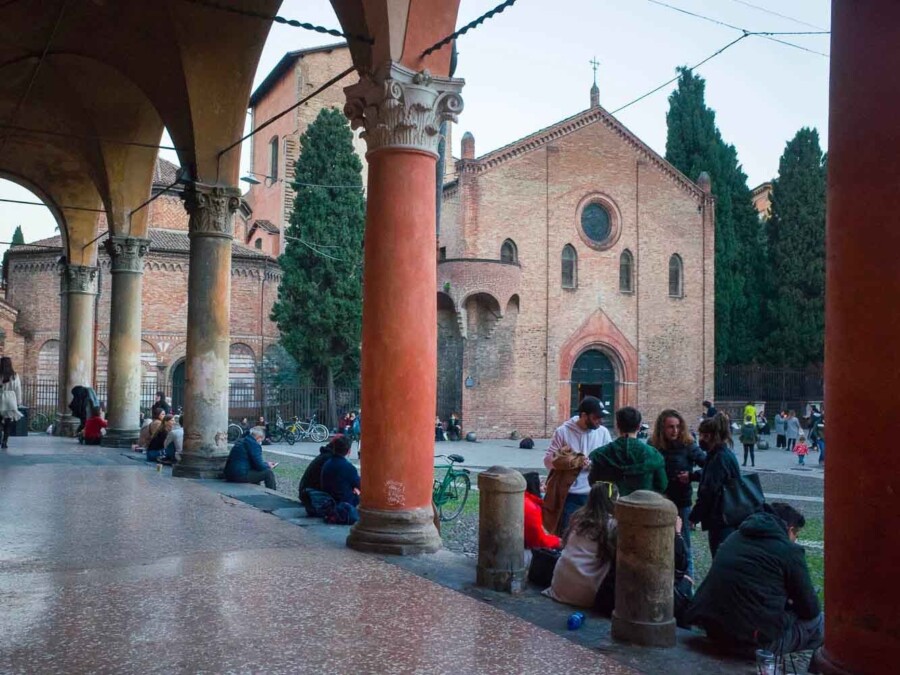
Known as the Seven Churches, Santo Stefano is Bologna’s spiritual heart.
This complex once contained seven interconnected churches, built to represent the Passion of Christ — from Gethsemane to the Holy Sepulchre.
Today, four main churches remain, connected by cloisters and courtyards that feel lost in time.
As you walk through the stone halls, it’s easy to forget the bustling city just outside. You’re stepping through centuries of history.
Don’t miss the crypt, the ancient Lombard columns, and the Courtyard of Pilate.
And yes, this is the answer to your question: What are the seven churches in Bologna? You’ll find them — or what’s left — right here.
3. San Luca
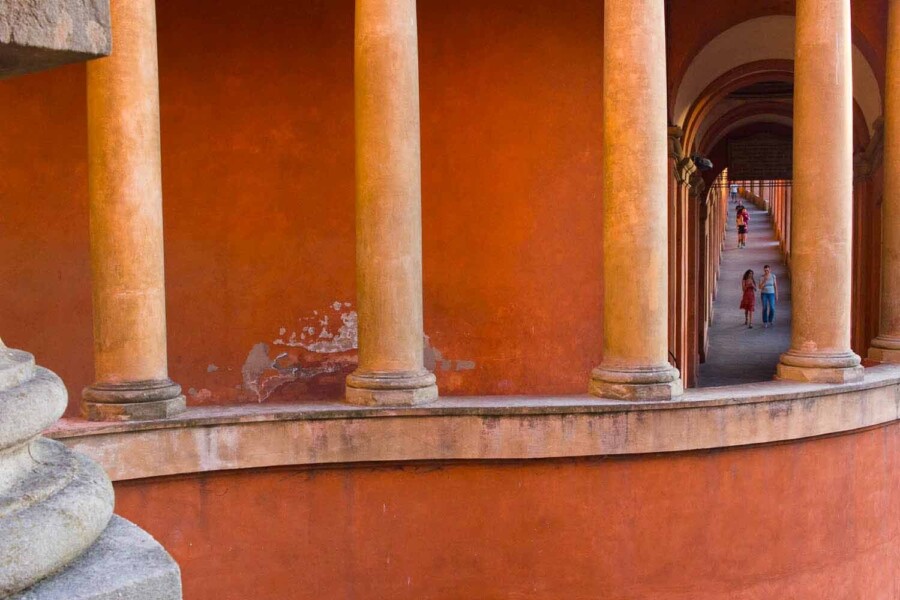
Sitting high on Colle della Guardia, the Sanctuary of San Luca is much more than a church — it’s a symbol of Bologna. For locals, seeing its dome on the hill means one thing: you’re home.
The walk to the top, under the world’s longest portico (666 arches), starts at Arco del Meloncello. It’s about 4 km and a beloved tradition.
Some walk for faith, often after making vows for healing. Others run or train — yes, San Luca is also a local gym.
At the summit, you’ll find sweeping views of the city and a sacred Byzantine icon of the Madonna, believed to protect Bologna.
Too tired?
Take the bus 58 from Meloncello for €2.50.
But if you can, walk it — it’s the most authentic experience, especially on a Sunday morning.
4. San Pietro (Bologna Cathedral)
Tucked away on Via Indipendenza, just a short walk from Piazza Maggiore, the Cathedral of San Pietro might not be as instantly striking as San Petronio — but don’t be fooled.
This is the official cathedral of Bologna and the beating heart of its religious life.
Step inside and you’ll be welcomed by soaring baroque columns, soft light filtering through high windows, and a sense of solemn grandeur. The interior is elegant and spacious, with beautiful side chapels, ornate altars, and richly decorated ceilings.
One of its highlights is the bell tower, the tallest in Bologna.
You can even climb it on certain days for a stunning view over the rooftops and towers of the city.
But San Pietro isn’t just for sightseeing — it’s alive.
Locals come here for weddings, baptisms, and religious holidays.
If you’re lucky, you might catch a choir rehearsal echoing through the nave or walk in during a quiet mass.
5. San Domenico

San Domenico is one of Bologna’s most important churches, not just for its beauty, but for its incredible role in religious and artistic history.
This is where Saint Dominic, founder of the Dominican Order, is buried. Pilgrims have been visiting his tomb for centuries, and for good reason: it’s a masterpiece of Renaissance sculpture.
The marble Arca di San Domenico is breathtaking.
It was started by Nicola Pisano, enriched by several artists, and completed by none other than Michelangelo — yes, that Michelangelo.
When he was still in his early twenties, he carved three figures here, including a striking angel holding a candlestick. You can already sense the genius that would later shape the Sistine Chapel.
And seeing it up close?
It’s unforgettable. The detail, the movement, the life in the marble — it feels as if the sculptures are about to breathe.
But the magic doesn’t end there.
Behind the main altar, you’ll find a stunning wooden choir, finely carved and beautifully preserved.
The side chapels are full of hidden gems, and the cloister offers a peaceful break from the city noise — a perfect place to pause and reflect.
6. Santa Maria della Vita
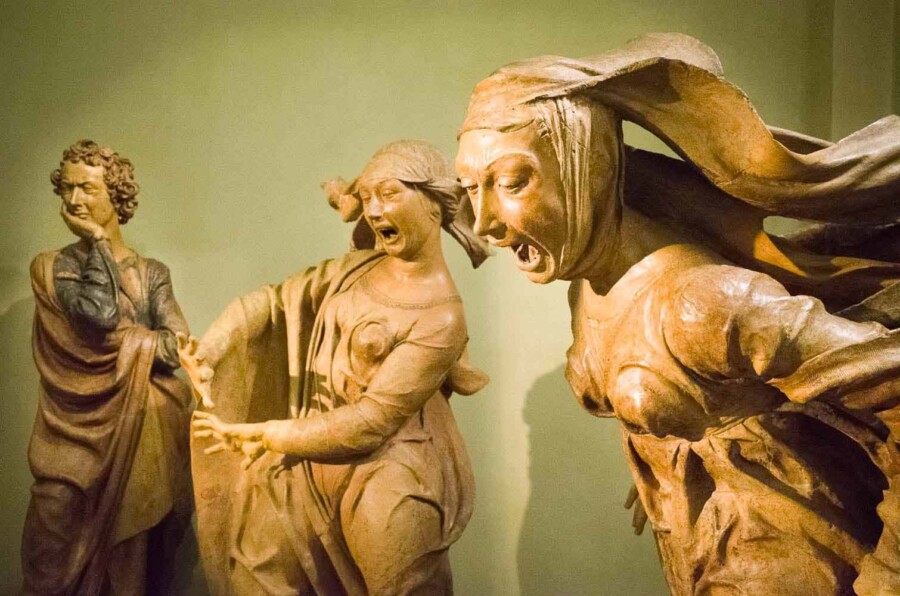
Santa Maria della Vita is small in size but enormous in emotional impact.
Located just a few steps from the bustling Quadrilatero market, it’s easy to miss — but trust me, you don’t want to.
The church houses one of Bologna’s most extraordinary sculptures: the Compianto sul Cristo Morto (Lamentation over the Dead Christ) by Niccolò dell’Arca.
The moment you see it, you stop.
You breathe in.
And then the emotion hits you.
Seven life-sized terracotta figures surround Christ's body in agony and disbelief. The expressions are so raw, so intense, that it's hard to believe they were made in the 15th century.
Some say the screaming figure of Mary Magdalene was the inspiration for modern cinema’s portrayal of grief. That’s how powerful it is.
But many visitors miss what’s upstairs.
Climb the staircase and you’ll find the Oratory, a stunning space filled with baroque stucco work and home to another emotional masterpiece: the Transit of the Virgin by Alfonso Lombardi.
This terracotta group is more serene than the Compianto, but just as moving.
The Virgin lies on her deathbed, surrounded by mourning apostles — each one modeled with care and humanity.
7. Santa Cecilia
Tucked away on Via Zamboni, near the university district, Santa Cecilia is one of Bologna’s hidden gems.
Step inside and you'll understand why some call it the “Sistine Chapel of Bologna.”
The church is covered in an incredible cycle of early Renaissance frescoes, narrating the story of Saint Cecilia, the patron saint of music, and her husband Valerian.
These frescoes were painted by Bologna’s greatest artists at the turn of the 16th century: Francesco Francia, Lorenzo Costa, and Amico Aspertini, among others.
The style is elegant and full of narrative detail — from Roman soldiers and angels to dreamlike architecture. It's a visual novel in color and line.
What makes Santa Cecilia special is the intimacy of the space.
Unlike more famous fresco cycles, you can stand just a few feet away from the art, without crowds or time limits. It’s quiet, immersive, and incredibly atmospheric.
If you’re a fan of Renaissance art, you’ll feel like you’ve stumbled upon a secret.
8. San Giacomo Maggiore
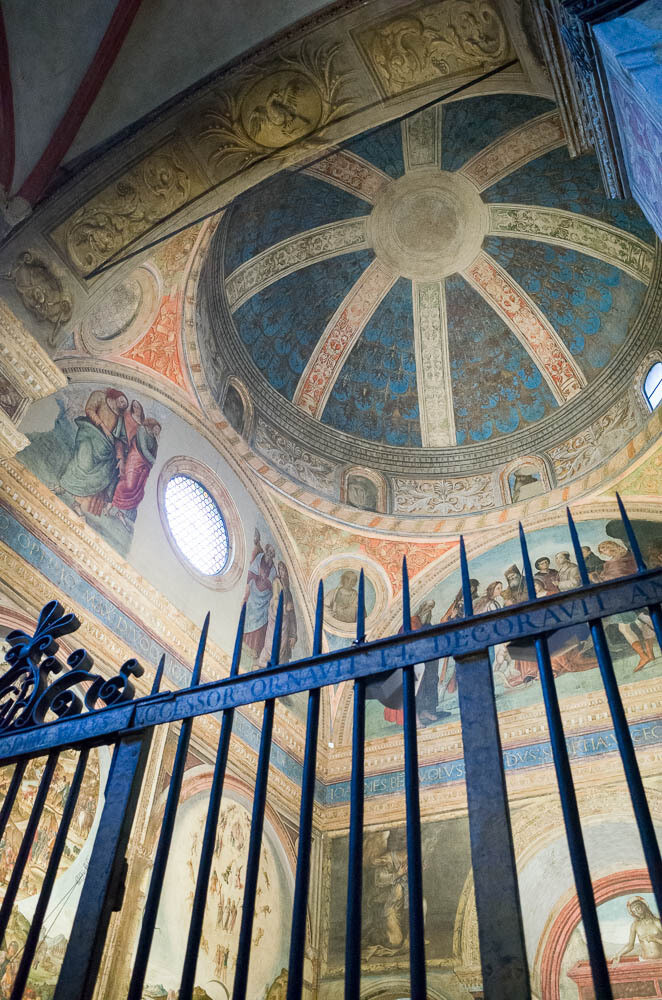
Located along Via Zamboni, just a few steps from Santa Cecilia, San Giacomo Maggiore is a perfect continuation of your artistic walk through Bologna.
Built in the 13th century by the Augustinian order, the church is a harmonious blend of Gothic architecture and Renaissance refinement.
The interior is spacious and filled with light, creating a peaceful, uplifting atmosphere.
But the real treasure lies in the Bentivoglio Chapel, one of Bologna’s most important Renaissance spaces.
Commissioned by the city’s ruling family, it’s adorned with frescoes by Lorenzo Costa and features a magnificent tomb sculpted by Jacopo della Quercia.
The symbols of power and faith intertwine here — angels, family emblems, and the Madonna all coexist in a richly decorated space that tells a story of devotion and dynasty.
Before you leave, step into the adjacent cloister, a hidden oasis of calm.
9. Santa Maria dei Servi
Located on Strada Maggiore, Santa Maria dei Servi impresses long before you enter — thanks to its striking portico.
This grand colonnade stretches across the piazza in front of the church, offering one of the most photogenic spots in Bologna.
Inside, the church has a serene Gothic interior with slender columns, vaulted ceilings, and a sense of spacious silence. Built by the Servite Order in the 14th century, it was designed with both humility and grace in mind.
The high altar is elegant, and the side chapels hold fine artworks and quiet candles. Occasionally, you might hear the faint sound of a classical concert echoing under the arches — the church often hosts music events, especially organ and choral performances.
Locals love this space for its stillness and grandeur. It’s a beautiful reminder of Bologna’s spiritual roots, hidden in plain sight.
Tip: visit in the late afternoon when the light filters perfectly through the columns of the portico.
10. Chiesa del Corpus Domini
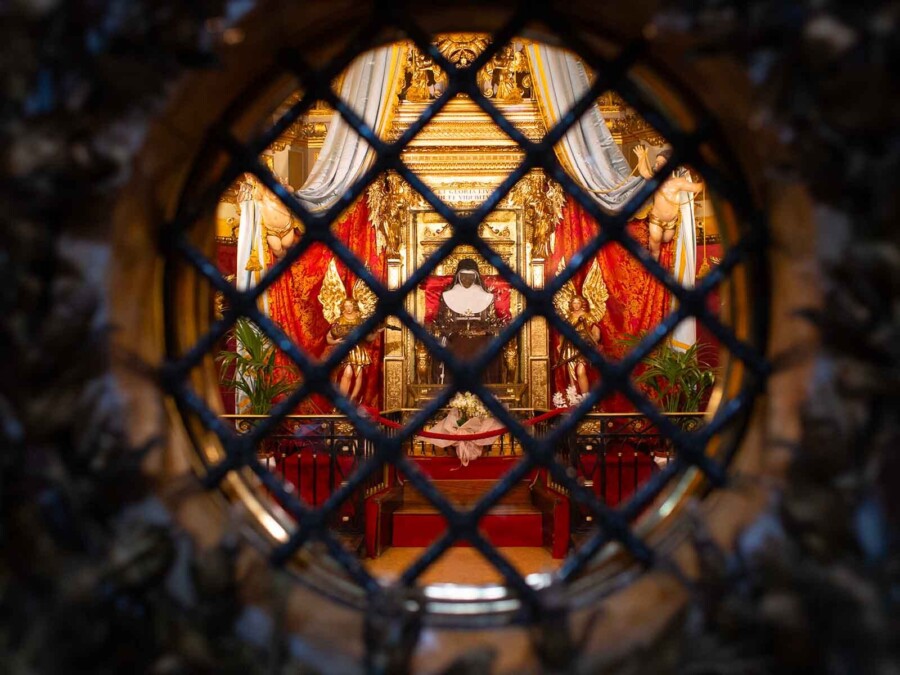
Looking for something truly off the radar — and a little mystical?
Visit the Chiesa del Corpus Domini, tucked away in a quiet side street near Via Tagliapietre. This church is part of a cloistered convent and houses something that will leave you speechless: the incorrupt body of Saint Catherine of Bologna.
Yes, you read that right.
Saint Catherine of Bologna was a 15th-century nun, mystic, artist, and writer. When she died in 1463, her body was buried — but soon after, strange things began happening. The scent of roses, visions, and miracles. So her sisters exhumed her… and found her body perfectly preserved.
Today, you can see her mummified body seated upright in a glass case, holding a crucifix, inside a small chapel behind the altar.
It’s a powerful, humbling experience — not macabre, but deeply spiritual.
The church itself is serene, with soft lighting and a strong sense of stillness. It’s not always open to the public, so check visiting hours in advance.
If you’re lucky, one of the nuns might even greet you with a quiet smile and a whispered blessing.
11. Chiesa di Riola
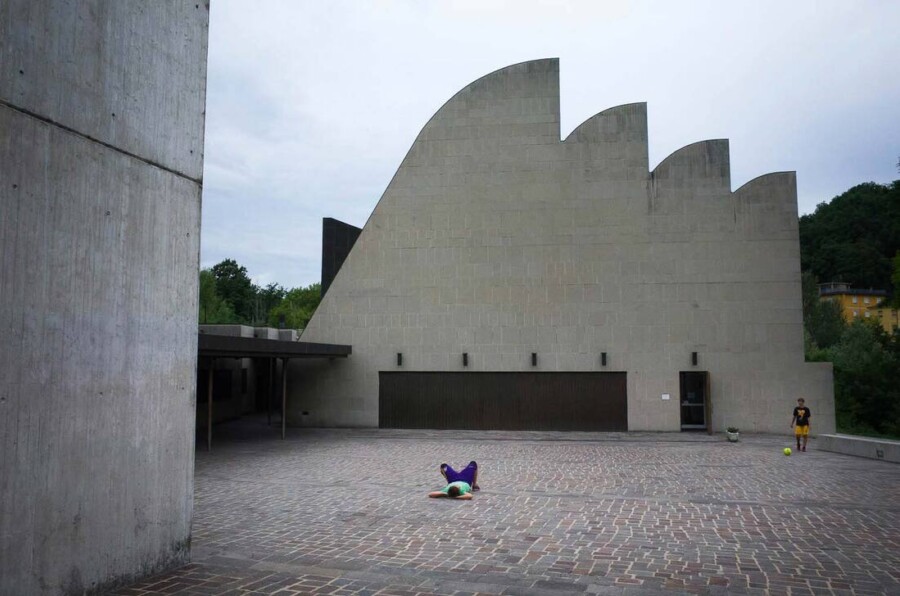
Ready for something completely different?
Drive about one hour southwest of Bologna, toward the Apennine mountains, and you’ll reach the small village of Riola di Vergato. Here stands a church that breaks every rule of Italian sacred architecture.
Designed by the legendary Finnish architect Alvar Aalto, the Chiesa di Santa Maria Assunta di Riola is a modern marvel. Completed in the 1970s, it combines Nordic minimalism with a deep sense of peace.
Light floods in from large, sloped skylights. White concrete walls curve gently toward the altar. The space feels open, silent, and deeply contemplative — a total contrast to the ornate churches in the city.
And the setting?
Surreal.
The church sits just minutes away from the Rocchetta Mattei, a fairy-tale castle full of Moorish architecture. It’s the perfect day trip for architecture lovers and curious explorers.
Yes, it’s off the beaten path. But it’s absolutely worth it.
Conclusion
Step into any church in Bologna and you’re not just entering a sacred space — you’re crossing into a world where art, faith, and history still speak to those who listen.
From the mystery of San Petronio to the emotional depth of the Compianto in Santa Maria della Vita, each visit reveals a new layer of the city. Whether you walk up to San Luca, admire Michelangelo in San Domenico, or discover the incorrupt Saint Catherine at Corpus Domini, these sacred spaces leave a mark.
To truly grasp their meaning, don’t just visit — experience them with a professional local guide.
Contact me to arrange a private tour that unlocks secrets, legends, and stories, bringing these churches to life.
Bologna is waiting to be discovered — one church at a time.
